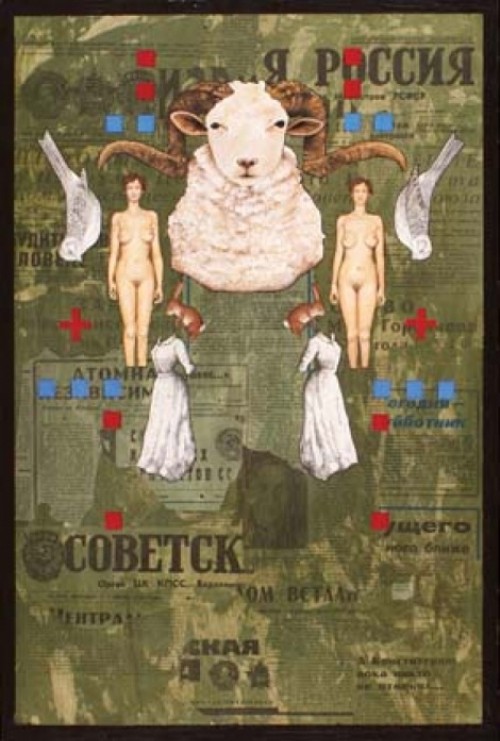Visual Art | Whisper to a “Screamâ€: Inspired by Munch, David Ruhlman creates his own visions of mysticism and apocalypse.
By Brian Staker @stakerizedRuhlman mentions an unlikely inspiration: Edvard Munch, whose well-known painting “The Scream” doesn’t appear reminiscent of Ruhlman’s measured and subtle work at all. But Ruhlman explains that much of the work in this show was created after he read Munch’s biography After the Scream, which detailed the Norwegian artist’s obsessions with sex, death and spirituality.
nThese themes have been essayed by Ruhlman from the beginning, but this series feels like a culmination of his work, a new level of maturity. His gouaches on wood panels use figures in human and animal form, as well as totemic-appearing objects like trees, red crosses and disembodied limbs in a folk-art style that uses repetition of these figures to emphasize their visual resonance. One of the most striking things about his works is that almost all are bilaterally symmetrical, their left and right sides mirroring one another. “It didn’t occur to me that the mirroring is echoed in the title of a painting,” Ruhlman admits about the work “The Left Hand of Edvard Munch is the Right Hand of God.” The symmetry makes the experience of viewing them unsettling, as in the postmodern world we are used to compositions that aren’t balanced perfectly.
nMunch’s interest in nature was unusual, though: Rather than romanticize it, “His interest was to leave his works outside in the belief that if they could weather the elements, they could withstand the rigors of the art world,” Ruhlman explains. The figures in Ruhlman’s work are weathering the bleak climates of war, injury and an iconography that mixes pagan nature worship with Christian imagery, like a body that might be Jesus with the head of an elk. Nude figures add a hint of sexuality, but they are posed like religious paintings. Pages from Soviet-era Russian newspapers in the background reinforce a World War II environment of grayish uniforms and fighter planes above miniature villages capable of little defense. The imposing head of a ram in the center of the large piece “The Earth Is a Secret Knot” is part power animal, part Christian symbol and part sacrificial animal marking a scene of an aftermath of violence.
nThe 34-year-old Ruhlman began creating art by making collages about 20 years ago. Then he moved on to book objects, which showed at the late Object Gallery in Salt Lake City and more recently this year at Houston’s Baptist University. This show takes up the most ambitious group of his paintings so far, several of them in triptychs that further reinforce the iconic aspect. Other paintings in this show trace his development, with early aesthetic hinted at by works that are a jumble of shapes interwoven. Ruhlman feels that his early childhood as an “Army brat” living in different places around the country and in Germany influenced the Eastern European wartime look of his work.
nMichael Friberg’s photographs and Jim Despain’s linoleum prints balance out the show with the documentarian approach of the former and the illustrative landscapes of the latter—two extremes. Ruhlman’s intersection of nature, history and myth can be placed squarely in the middle.
nRuhlman’s bleak scenarios keep whatever dark sense of humor very well hidden, but the one piece that is overtly funny is “The Godhead,” with the head of Jesus atop a body of conjoined twins. “I’m trying to work through my belief system,” the agnostic Ruhlman explains. He and his fiancée Rachel Marston appear as nude figures in sections of “The Earth” resembling Adam and Eve, frozen like all his figures in static poses. “The female figure is an allusion to a woman in a work by Albrecht Dürer,” he adds.
n“The Earth” is subtitled “Nov. 7, 1937,” the date poet Antonin Artaud predicted the end of the world. Ruhlman‘s own vision is also apocalyptic: “I like the idea of looking up into the sky, seeing the beginning and end of time at one moment, the veil torn open and everything revealed, before it all collapses.” His work is a recapitulation of human history, from the beginnings of the individual fetus to the species’ eventual end.
nn
DAVID RUHLMAN: PAINTINGS
nFinch Lane Gallery, 54 Finch Lane, 596-5000, Jan. 9–Feb. 20. tttt
More by Brian Staker
-
Live Music Picks: April 12-18
Judas Priest, The Residents, Clownvis Presley, The Breeders and more.
- Apr 11, 2018
-
Loving the Alienation
Helios Creed and Chrome continue making iconoclastic music for outcasts.
- Mar 28, 2018
-
Live Music Picks: March 22-28
U.S. Girls, Ed Schrader’s Music Beat, Hell’s Belles, Columbia Jones and more.
- Mar 21, 2018
- More »
Latest in Arts & Entertainment
Readers also liked…
-
New TV for January 2023
Mayfair Witches, Velma, The Last of Us, Poker Face and more premieres
- Jan 4, 2023



